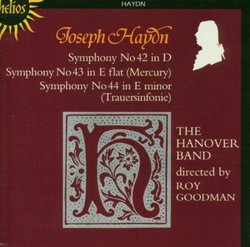| All Artists: Haydn, Goodman, Hanover Band Title: Haydn: Symphonies 42-44 / Goodman Members Wishing: 0 Total Copies: 0 Label: Hyperion UK Release Date: 11/12/2002 Album Type: Import, Original recording reissued Genre: Classical Style: Symphonies Number of Discs: 1 SwapaCD Credits: 1 UPC: 034571151175 |
Search - Haydn, Goodman, Hanover Band :: Haydn: Symphonies 42-44 / Goodman
CD Details |
CD ReviewsExploring the Haydn Symphonies -- Nos. 42,43,44 Robin Friedman | Washington, D.C. United States | 07/24/2006 (5 out of 5 stars) "Between 1776 and 1772, Haydn composed 17 symphonies in which he took the form's emotional and musical content to a new level. Of this group, six symphonies, a high proportion, are in a minor key, leading some commentators to attach the label sturm und drang (storm and stress) to Haydn's compositions of these years. The term is appropriate for some but not all of the symphonies of this highly productive time in Haydn's life. The three symphonies from this period on this CD include one great work, the "Trauer" symphony, number 44 to which the sturm und drang label applies, but it includes two contemporaneous symphonies, nos. 42 and no. 43 to which this label is inappropriate. Symphonies 43 and 44 are relatively well known and frequently recorded while symphony no. 42 is a rarity.
On this CD, Roy Goodman conducts the Hanover Band on period instruments and uses a harpsichord continuo. The recording dates from the early 1990s and is on the low-priced Helios label. I have been greatly impressed by Goodman's performance of the Haydn symphonies, and this CD is among his finest. The Symphony no 42 in D major was new to me, and it deserves to be heard. It is an expansive, ambitious work of pure, nonprogrammatic music. Haydn took the trouble to attach adjectives to his directions for three of the four movements. The opening moderato e maetsoso is a lengthy, large-scaled movement with a spacious opening theme, and great dynamic and thematic contrasts, with repeated flourishes for the horns. It features a false recapitulation, as does symphony no 43, in the midst of the development section. The next movement, andantino e cantabile, is also extended in character as Haydn develops and embellishes two lengthy flowing themes. This lovely movement was used to illustrate the intricacies of sonata form in an early treatise on composition. The minuet is short and based on simple melodic lines, in contrast to the complexity of the first and second movements. The finale, marked scherzando e presto, is the first fully-developed rondo in a Haydn symphony. It features strings and winds alternating and sudden stops. Symphonies 43 and 44 are much better known than no. 42. The 43 symphony in E -flat major has the nickname "Mercury" for reasons that remain obscure. It has become one of my favorite Haydn symphonies and is beautifully performed on this CD. This work was probably used as an accompaniment to a play at Esterhaza, but regardless, the work remains, as H. Robbins Landon described it, "a chamber symphony par excellence." It is an exquisite, elegant, and sophisticated example of Haydn's art. The work opens quietly with a three-note motif which Haydn expands into a movement of great contrasts between intimacy and power. The andante is the longest movement in the work and also features a three-note theme which becomes the basis for a long melody. It is predominantly scored for the strings. The movement is in three-part form with a short dramatic middle section separating two lyrical sections. The minuet also is based upon a three-note phrase, giving a great deal of thematic continuity to the symphony, and the trio in the strings has a poignant quality. The rondo finale is based upon a rustling, ambiguous opening theme which develops into a lengthy, vigorous close. The "Trauer" (mourning) symphony, No. 44 in E minor is likely the greatest of Haydn's six sturm und drang minor key symphonies. The work includes stormy, angry, and angular writing and complex counterpoint. It also includes a serene, contrasting third movement. Much of the work is in the form of statment and response. A portion of the orchestra plays an opening phrase which is echoed and expanded upon by other instruments. The first movement, allegro con brio, is based upon repeated use of this pattern followed by extensive development of the theme in counterpoint. The second movement of the Trauer is the minuet, which is also contrapuntal, with an opening statement of the phrase and a canonic response. It remains in the tragic minor key with the exception of the lyrical trio. The slow movement of the Trauer is of great noblility and serenity and serves as a respite from the passions of the remaining three movements. This movement always reminds me of an air from a Gluck opera. The theme is mostly in the strings with the winds entering in force at climactic moments. The work comes to a severe close in the minor key in the rapid finale in which a statement-response structure of the opening theme again gives way to contrapuntal treatment. This CD offers an excellent opportunity to hear Haydn's symphonic mastery, in works both familiar and unfamiliar." |

